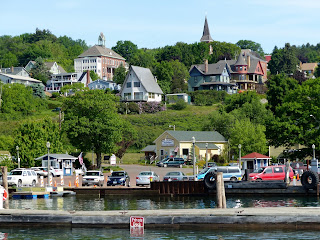We went to visit our friends Larry and Ruth in Grand Rapids, Minnesota. They were going to take us to Voyageurs National Park in his boat, but George didn't want another experience like the Isle Royale cruise where we froze on the boat ride. The weather was iffy (then turned out to be beautiful, of course!), so George opted for a drive to a couple of the Visitor Centers so he could get some passport stamps.
There are three Visitor Centers, but we only went to two of them. The one in Ash River is in the historic Meadwood Lodge. The interior doorways aren't very high, so George had to watch his head.

The Voyageurs of Grand Portage National Monument were the same Voyageurs here, only here it's not the place for rendezvous, it's the middle of the journey. The fur traders would go as far north as the Athabaska country in what's now Canada, 3,000 miles from Montreal, most of it by water. The area the park covers is through several lakes: Crane, Sand Point, Namakan, Kabetogama, Rainy. There are more than 500 islands and 650 miles of shoreline, 340 square miles of land and water. We missed a lot not getting on the water. If we ever go back, that's what we'll do.
Next stop was Kabetogama Lake Visitor Center. There's a pretty public boat dock and a tiny glimpse of the kind of rocks you'd see on some of the islands. The four of us wandered around the little museum and then watched the video.
Just behind the Visitor Center is a beaver lodge built on the bank. I didn't even know they built lodges like this. As you can probably guess, we didn't see the beaver...
There were lots of wildflowers around there. (Check out the pictures on the link below.) On the way back to Grand Rapids, Larry took us back a different way. There were fields and fields of wild daisies.
Then Larry took us to the Laurentian Divide. It's a ridge that directs the flow of the waters in Minnesota. All the streams and rivers on the north of the Divide flow into Hudson Bay and to the Arctic Ocean. Everything south flows to the Mississippi and the Gulf of Mexico. I'd never heard of it! I can't tell you how many times I've crossed the Continental Divide which splits the watersheds that flow into the Pacific on the west and the Atlantic on the east. But North? Who knew?
More pictures at this link: Voyageurs Natl Park



































































